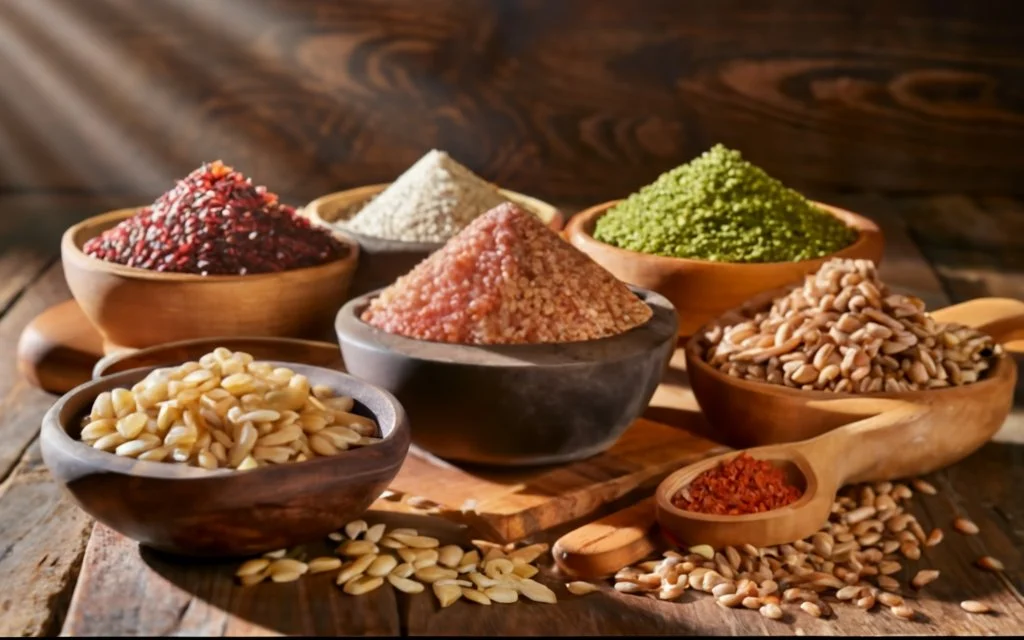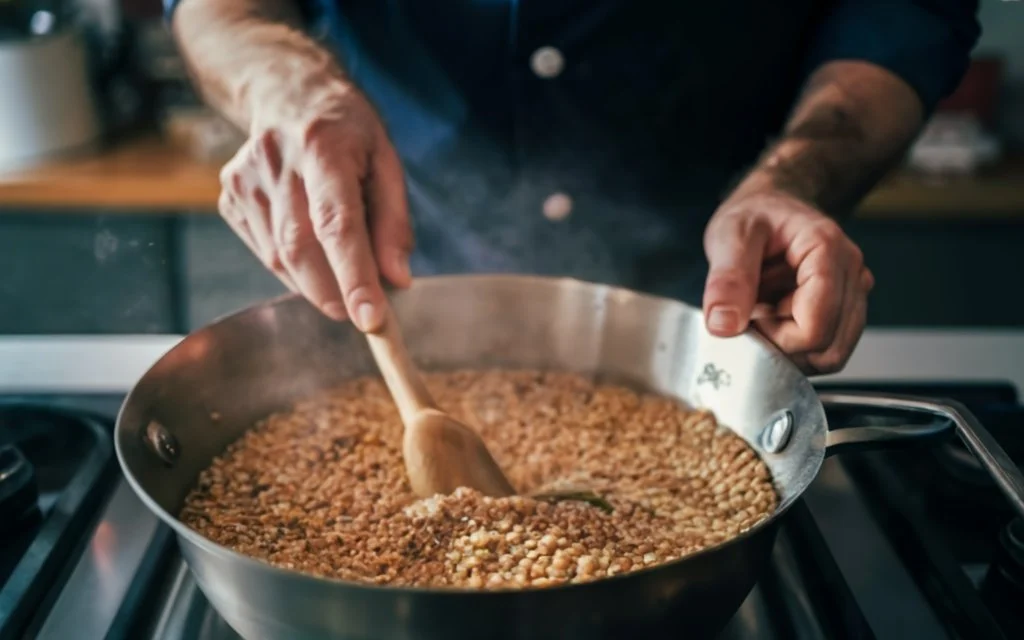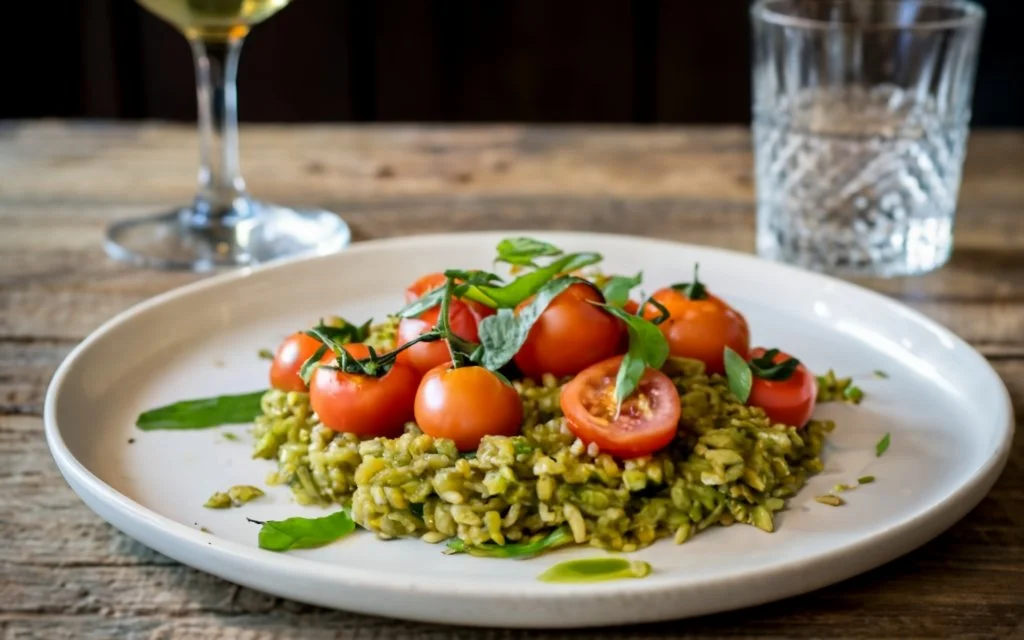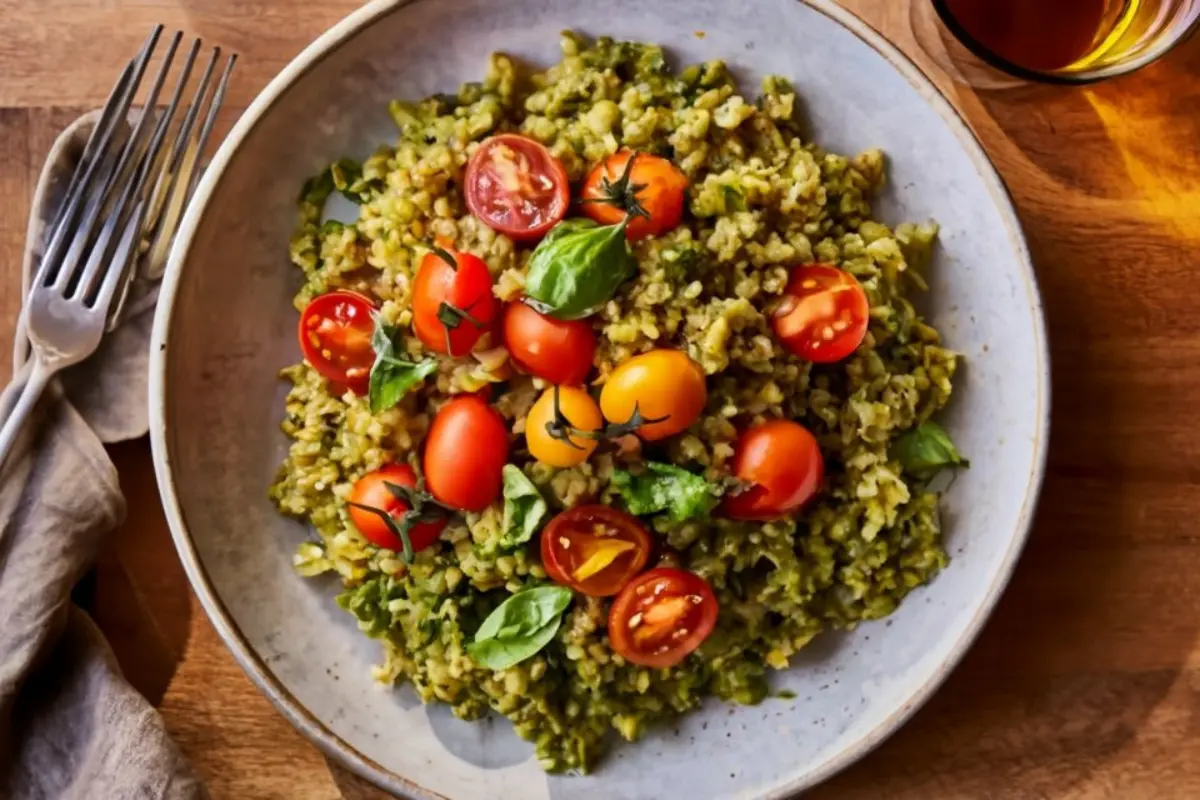Part 1: Introduction to Farro and Its Versatility

Introduction to Farro and Charred Tomato Pesto Dish
Farro, an ancient grain revered for its nutty flavor and delightful chewiness, is the star of our dish. But what really sets this grain apart? It’s its versatility. Whether you’re tossing it in a salad, simmering it in a soup, or pairing it with the tangy burst of charred tomatoes and the creamy depth of pesto, farro adapts beautifully, making it a staple in diverse culinary traditions.
The Historical Journey of Farro in Cuisine
Tracing back to ancient Egypt, farro has graced the tables of emperors and common folk alike. This grain was a cornerstone in ancient Roman diets, and today, it continues to be a beloved ingredient in Italian kitchens. Its journey through time is not just a tale of sustenance but also of cultural significance, weaving a rich tapestry of culinary history.
Health and Nutritional Aspects of Farro
But farro isn’t just about taste; it’s a powerhouse of nutrition. Packed with fiber, protein, and a range of vitamins and minerals, it’s a smart choice for those looking to enrich their diet. Its low glycemic index makes it a favorable option for blood sugar management, and its high fiber content is excellent for digestion. In short, farro is a grain that not only satisfies your palate but also nurtures your body. For more healthy ingredient ideas, check out our guide on rye crackers, another nutritious option for your meals. Learn more about the fiber-rich benefits of farro in this comprehensive article by Dr. Axe.
In the next section, we’ll turn up the heat and explore the vibrant world of roasted tomatoes, a perfect companion to our beloved farro. Stay tuned. For a deeper understanding of farro’s health benefits, check out this detailed overview by Healthline.
Part 2: Diving into Key Ingredients
The Appeal of Roasted Tomatoes in Cuisine
Now, let’s shift our focus to a key component of our dish: roasted tomatoes. These aren’t just any tomatoes; when roasted, they transform into a flavor-packed delight. Their skins blister, their sugars caramelize, and what you get is a burst of sweetness with a hint of smokiness. Moreover, they bring a vibrant color and texture to the plate, making farro with blistered tomatoes and pesto not just a treat for the palate but also a feast for the eyes. Just like the transformative effect of roasting tomatoes, exploring other ingredients like piquillo peppers can also elevate your dishes.
Crafting the Perfect Basil Sauce for Farro
Next up is pesto, the heart of our dish. Traditionally made with basil, pine nuts, Parmesan, garlic, and olive oil, pesto adds a creamy, herby layer to the robust textures of farro and tomatoes. Furthermore, it’s incredibly versatile – you can tweak it to your taste, maybe add a hint of lemon for zest, or swap pine nuts with walnuts for a different nutty flavor. The key here is to balance the flavors to complement the earthiness of farro and the sweetness of the tomatoes. If you enjoy Italian-inspired dishes, our recipe for Tuscan chicken meatballs and gnocchi is a must-try.
Selecting Complementary Ingredients for Farro Pilaf
Finally, to elevate our dish, we need to pick the right companions for farro. Think of ingredients that add a contrast or enhance the existing flavors. Fresh herbs, like basil or parsley, can add a pop of color and freshness. A sprinkle of cheese, perhaps feta or goat cheese, can introduce a tangy twist. And let’s not forget a drizzle of good quality olive oil for that final touch of richness. Each ingredient plays a crucial role in harmonizing the flavors of our farro with blistered tomatoes and pesto dish.
In the next part, we’ll dive into the art of preparing these ingredients to perfection. Stay tuned for some culinary magic!
Part 3: Culinary Techniques and Recipes

Mastering Farro Preparation
Preparing farro is a journey in itself. Firstly, it’s essential to rinse the grains to remove any impurities. Then, for cooking, a simple yet effective method is to simmer it in water or broth until it’s tender but still has a bite. Additionally, seasoning the cooking water with a bit of salt can enhance its natural nutty flavor. Remember, the goal is to achieve a texture that’s chewy and firm, not mushy, providing a perfect base for our farro with blistered tomatoes and pesto.
The Art of Sun-Kissed Tomato Roasting
Moving on to the tomatoes, the key to perfect blistering lies in the heat. Start by heating a pan until it’s really hot. Then, add the tomatoes with a bit of oil and let them cook undisturbed for a few minutes. This process allows them to char and blister, unlocking a depth of flavor that’s both sweet and smoky. Moreover, a sprinkle of salt and pepper during the cooking process can elevate their taste to new heights.
Homemade Pesto for Mediterranean Farro: A Guide
Now, let’s talk about making the pesto. Begin by blending fresh basil, garlic, pine nuts, and Parmesan cheese in a food processor. Gradually add olive oil until the mixture becomes smooth and creamy. Importantly, taste as you go and adjust the seasoning according to your preference. This homemade pesto will not only add a burst of flavor to the dish but also infuse it with a fresh, aromatic essence.
Assembling the Ancient Grain Salad
Finally, it’s time to bring all the elements together. Mix the cooked farro with the blistered tomatoes, then generously drizzle the pesto over the top. Gently toss everything to ensure the grains are evenly coated with the pesto and the tomatoes are distributed throughout. This step is crucial as it’s where all the flavors meld to create the harmonious and delicious farro with blistered tomatoes and pesto.
In the next section, we’ll explore creative ways to serve this delightful dish and suggest some perfect wine pairings. Stay tuned for more culinary inspiration
Part 4: Presentation and Pairings

Innovative Serving Ideas for Farro Dishes
When it comes to serving farro with blistered tomatoes and pesto, creativity is key. Firstly, consider the presentation. Serving this dish in a rustic bowl can highlight its Mediterranean roots. Additionally, garnishing with a few basil leaves or a sprinkle of Parmesan can add a touch of elegance. Also, think about texture; adding a crunchy element like toasted pine nuts or breadcrumbs can provide a delightful contrast to the chewy farro.
Ideal Wine Pairings for Farro and Pesto Meals
Now, let’s talk about wine pairings. A dish like farro with blistered tomatoes and pesto pairs beautifully with wines that complement its rich and earthy flavors. For instance, a light-bodied white wine, such as Pinot Grigio, can balance the dish’s robustness with its crisp acidity. Alternatively, if you prefer red wine, a Chianti with its fruity notes can be an excellent choice, enhancing the tomato’s sweetness and the pesto’s herby profile.
Part 5: Adaptations for Various Diets

Vegetarian and Vegan Options for Farro Salad
Adapting farro with blistered tomatoes and pesto for vegetarian and vegan diets is surprisingly simple. For vegetarians, the classic recipe works perfectly. However, for vegans, you can easily substitute the Parmesan in the pesto with nutritional yeast or a vegan cheese alternative. This swap maintains the creamy texture and savory flavor profile of the pesto. Additionally, using a vegetable broth for cooking farro can add an extra layer of flavor, making the dish even more appealing to those following a plant-based diet.
Gluten-Free Alternatives in Farro Cooking
For those on a gluten-free diet, while farro itself contains gluten, you can substitute it with gluten-free grains like quinoa or buckwheat. These alternatives not only mimic the texture of farro but also offer their own unique flavors. When using these substitutes in farro with blistered tomatoes and pesto, it’s important to adjust cooking times according to the grain you choose, ensuring the perfect texture for your gluten-free version of this delightful dish.
In the concluding part of our article, we’ll wrap up with some final thoughts on this versatile and flavorful dish, along with answering some frequently asked questions. Stay tuned for the conclusion of our culinary journey with farro with blistered tomatoes and pesto.
Part 6: Conclusion and FAQs
Concluding Thoughts on Farro with Blistered Tomatoes and Pesto
In conclusion, farro with blistered tomatoes and pesto is not just a dish; it’s a celebration of flavors, textures, and nutrition. This culinary creation beautifully marries the chewy, nutty farro with the sweet and smoky blistered tomatoes, all brought together by the rich, herby pesto. Moreover, its versatility in adapting to various dietary needs makes it a perfect meal for any table. Whether you’re a gourmet chef or a home cook, this dish is sure to impress and satisfy.
Frequently Asked Questions About Farro Dishes
- Can I use a different grain instead of farro? Absolutely! Quinoa or buckwheat are great gluten-free alternatives that maintain a similar texture.
- How can I make this dish nut-free? For a nut-free pesto, try using seeds like sunflower or pumpkin seeds instead of pine nuts.
- What’s the best way to store leftovers? Store in an airtight container in the fridge for up to 3 days. Reheat gently to preserve the texture.
- Can I add protein to this dish? Certainly! Grilled chicken or shrimp makes a great addition for a protein boost.
- Is this dish suitable for meal prep? Yes, it’s perfect for meal prep as the flavors develop beautifully over time.
Farro with blistered tomatoes and pesto is more than just a meal; it’s a nutritious, flavorful journey that’s sure to become a staple in your culinary repertoire. Enjoy the process, savor the flavors, and most importantly, have fun with it!

